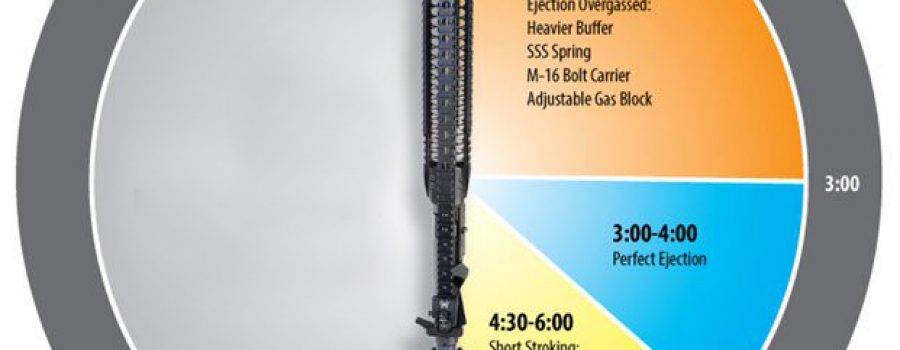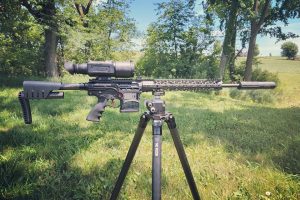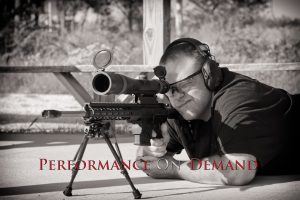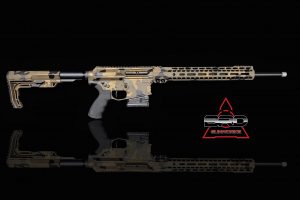- Forward ejection of spent cases- Between 12 o’clock and 3 o’clock
- Ejector swipes
- Torn case heads from the extractor
- Premature spring wear
- Double feed
- Blown primers/ Flattening of primers/ Cratered primers
The above concerns are commonly seen in over gassed AR’s, or AR’s with excessive operating pressures.
Over gassing is a condition in which the bolt carrier group has an excessive amount of gas pressure applied to it over a period of time, resulting in an increase of timing in the AR platform, which then correlates to non-optimal extraction and ejection of spent cases. If excessive enough, over gassing can result in functioning concerns and excessive wear on critical components.
What are some contributors to over gassing?
- Larger than optimal gas port diameters
- Long dwell time combined with large gas ports
- High pressure ammunition- Handloads or some factory ammunition
- Addition of a suppressor- Most suppressors will add back pressure, aka bore pressure
- Combination of the above listed factors
Pro Tip: the easiest “field expedient” way of checking timing (AKA gassing) is by observing where the firearm is throwing the spent brass. Here’s a caveat to this. Ejector spring and extractor spring tension will influence the ejection distance and position. Check out this article on extractor tips. Shoot 5-10 rounds and see where the spent brass is ejecting to and where it is landing. It should typically be making a nice pile, or “group” at a 3-4 o’clock position and typically six to eight feet away. If you shoot with a suppressor, repeat the previous check and note your findings. If you’re ejecting spent cases before the 3 o’clock position without a suppressor, it’s most likely that the gun is over gassed. If you add a suppressor and the group moves forward to a 1-2 o’clock position, you’re getting too much gas and the casings are coming out so fast they are hitting your deflector and bouncing forward.
Optimizing the buffer system to the gun increases the operational performance as well as reducing wear on critical components. This is where we start. If we are unable to get the gun properly timed either due to an excessively large gas port diameter, pressure of the ammunition being used, addition of a suppressor, or a combination of these factors then we look at adding an adjustable gas block to further regulate the port pressure downward.
In the AR platform, the gas that drives the system has several components which affect operation. First is the port pressure, which is determined by the location of the gas port on the barrel, and which also determines the length of time the gas has to travel to effect operation of the bolt.

Next is the size of the gas port, which determines gas volume introduced into the system.

Last, is the barrel length past the gas port, which determines the dwell time, or time that the system is pressurized.

The pressure factor of the ammunition being fired is the last variable related to gas. However, it should be noted, that when using suppressors which have bore pressure (AKA backpressure) created by the baffle-chamber design most common in the industry, this effectively lengthens the barrel, often dramatically increasing the dwell time and creating additional prolonged pressure on the breach-face of the bolt. These characteristics creates an over gassed condition, increased cyclic rate, felt recoil, and blowback into the action which in the AR platform will result in gas exiting the ejection port and sometimes through the charging handle.
The three core components to the AR operation trifecta are:
- Springs
- Gas
- Mass
In that order.
It is through adjustments of these core components that we achieve optimal performance characteristics in the AR platform, and within reason can reduce over gassing and the effects that it has.
The action spring (AKA buffer spring) to a large degree determines how long the bolt carrier group stays locked in battery. It regulates the speed of the reciprocating mass, which in the AR is the bolt carrier group and the buffer. The buffer spring slows the mass, and it also creates the force which returns the bolt carrier group back into battery. Action springs such as those by Springco USA come in various spring rates and allow you to tune the system. Other springs such as the magazine spring and hammer spring also contribute slightly to the timing of the gun as they do provide slight resistance in the rearward stroke of the bolt carrier group.

For the more technical minded people, force divided by mass gives you acceleration, so if you increase the mass of the buffer you can slow down the cycle of the bolt. But, reciprocating mass affects the tuning in a couple of ways. By increasing weight you increase the amount of time it takes for the reciprocating mass to begin moving.

This is a benefit in over gassed guns, guns that are under sprung, and guns that have a longer dwell time in that it aids in keeping the bolt carrier group in battery which in turns reduces chamber pressure. Once the heavier mass starts moving it also moves slower the heavier it is. This reduces the cyclic rate. Now for the negatives of a heavier reciprocating mass. Too much reciprocating mass can cause the chamber pressure to be reduced too much, and create functional concerns. Heavier reciprocating mass provides for more felt recoil over a longer duration. This is due to the mass bottoming out against the bottom of the buffer tube, and the amount of time it stays there due to the buffer spring taking longer to get that mass moving forward. All of this will typically translate into more movement of the firearm which directly affects how much the reticle moves when firing a shot. This can increase the difficulty of spotting your own shots or to quickly place follow-up shots. Excessive reciprocating mass can also cause premature gas ring wear.
Bottom line is that empirical data has shown that increasing spring rate and then increasing buffer weight as required provides for better performance in the AR platform, as well as reducing wear on critical components.
This also applies to most SCS buffer systems. Systems such as the JP SCS allow you to tune the SCS using various springs that are of different spring rates, as well as replacing the steel weights with tungsten weights that you can purchase.


It should be noted that not all SCS style buffer systems will allow you to change spring rates. They only allow you to change the weights. This is the equivalent of only installing a heavier buffer.
While I’m not a proponent of adjustable gas blocks on duty or defensive AR’s, I do use them on predator hunting and competition guns. The adjustable gas block, such as SLR Rifleworks, allows us to reduce the amount of gas flow through the block, which is effectively like reducing the gas port diameter.

Another benefit of using an adjustable gas block for AR’s in these roles is that a lower reciprocating mass can also be used. This can be in the form of a lower bolt carrier weight, a lower buffer weight, or a combination of both. Remember how I stated earlier that a heavier mass will increase felt recoil over a longer duration of time? The opposite is true for a lighter mass. It will reduce felt recoil, reduce the duration of the recoil, and in most cartridges will change the recoil impulse to more of a quick and sharp hit which does not move the gun as much and results in less reticle movement. But when using a low mass system you must use an adjustable gas block and have it set correctly. Otherwise you can run into operational concerns as well as premature component failures.
When adjusting gas blocks, what I have found best with most cartridges is to set the gas block so that it always locks back on an empty mag after firing one shot with the ammunition that I will be using. I will then verify this with a couple of 3 shot sequences to verify last round bolt hold open on an empty mag. If a gas block is set right at that ragged edge of reliability, it may lock the bolt open after one round, but fail to do so after a string of 3 quickly fired shots. Once I get consistent last round bolt hold open I will generally turn the gas block screw out one to two more turns. I’ve found that this provides me with an operational envelope that will work year around and with the range of ammunition that I use. Now if going to a location that may have a significant elevation or atmospheric change, then you may find that you need to make additional adjustments.
While this is not in-depth information, but more of a hitting the wave tops type of article, I hope this gives you a better understanding of the relationship of the gas system and buffer system.
BRD Gun Works~ Performance on Demand



